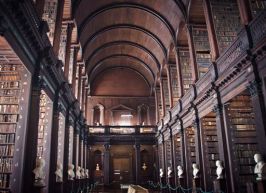
A Christmas Carol
- Parable
- Victorian literature
What It’s About
Haunting Holiday Cheer
Many people think they know Charles Dickens’s classic tale of a bitter old miser, Ebenezer Scrooge, who, thanks to a series of ghostly encounters, learns to embrace the spirit of Christmas. But while the story of Scrooge’s redemption has been retold countless times over the years, A Christmas Carol retains its ability to surprise and provoke. It’s not just that Dickens shaped popular notions of the celebration of Christmas – though his narrative certainly left its mark on the holiday. The novella’s definition of the “spirit” of the season as a blend of earthly pleasures and selfless benevolence offers a heartwarming picture of how kindness and care for others can save an individual soul and, at the same time, a haunting warning. Alternately comical, sentimental and horrifying, Dickens’s creation entertains without shying away from its larger message about the dangers – both personal and societal – of ignoring Want and Ignorance and otherwise eschewing responsibility for those in need.
Summary
About the Author
Charles John Huffam Dickens was born on February 7, 1812 in Portsmouth, England, to John Dickens – a clerk in the Navy Pay Office – and Elizabeth Dickens. The second eldest of eight children, Dickens enjoyed a happy childhood and was a voracious reader from a young age. The family moved to London in 1822. Two years later, the Dickens’ habits of living beyond their means caught up with them: John Dickens was forced into a debtors’ prison, and the 12-year-old Charles was made to leave school and go to work in a boot blacking factory. The poor working conditions he suffered informed his later fiction-writing. Upon his father’s release, Dickens briefly returned to school. At age 15, he became a clerk in a solicitor’s office, but soon left to become a freelance reporter covering court proceedings. Dickens began writing stories in 1833. The success of his collection of journalistic pieces, Sketches by Boz (1836) garnered the attention of the publishers, Chapman and Hall, who invited him to write text to accompany the works of a well-known artist. That serial, titled The Pickwick Papers, proved popular, and helped prompt Charles’s decision to quit newspaper work in favor of editing a monthly magazine, Bentley’s Miscellany. That same year, Dickens married Catherine Thomson Hogarth with whom he had 10 children. Dickens published one of his most popular works, Oliver Twist, as a serial in Bentley’s from 1837 to 1839. Other novels were, likewise, serialized between 1838 and 1841, and many were adapted into plays. A trip to America helped cement Dickens’s growing sense of himself as a public figure, with an obligation to try to influence society for the better. A Christmas Carol (1843) underscored his determination that his art serve to both entertain and do good. The years between 1849 and 1856 saw the publication of some of Dickens’s most accomplished fictions, including the semi-autobiographical David Copperfield (1850). In 1857, Dickens fell in love and began an affair with the actress Ellen Ternan. After separating from his wife, he embarked on a series of well-received public reading tours, and published A Tale of Two Cities (1859) and Great Expectations (1861). Dickens suffered a stroke while working on his final novel, The Mystery of Edwin Drood, and died on June 9, 1870. He was buried in the Poets’ Corner of Westminster Abbey.











Comment on this summary or Start Discussion